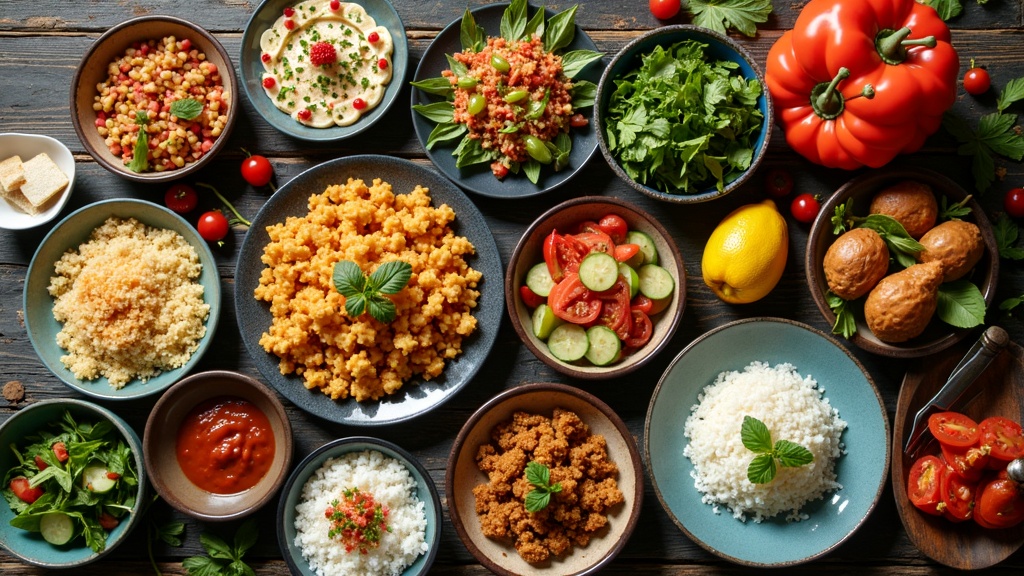Plantbased cuisine is taking over menus worldwide, and watching how it evolves from country to country is genuinely fascinating.
Whether you’re trying to incorporate more meatfree options or you just love seeing what creative chefs come up with, it’s a good time to track down what’s trending.
I’ve gathered insights from chefs, food writers, and culinary experts to show where plantbased food is headed this year and why it’s more than just a health kick.
It’s shaping global food culture in exciting ways.

Why Plantbased Cuisine Is on the Rise Globally
Plantbased eating isn’t a new concept; plenty of cultures have roots in vegetarian and vegan traditions.
What’s different now is how mainstream the movement has become.
According to food trend analysts, plantbased food sales are growing year after year, while restaurants across the world are making it a focal point—no longer just a side option.
There are several reasons for this surge.
Health is a major factor, since people want to eat meals that offer energy and wellness.
Sustainability motivates many; plantbased food uses fewer resources compared to traditional animalbased dishes, making it a very attractive choice for diners who care about the earth.
Plus, global curiosity has taken off.
Social media puts new foods on display, so you can see what’s happening with food in Tokyo, Barcelona, Nairobi, or anywhere else, and bring that inspiration to your own table.
Chefs and food writers I’ve spoken to highlight a major switch up: more people are making vegetables, grains, and legumes the heart of the meal, not just an add-on.
Plantbased cooking is revealing bold flavors and fun textures, making it a popular worldwide trend.
Expert Panel: Current Global Plantbased Trends
To get the freshest perspective, I asked six culinary experts who spend their days shaping or observing plantbased trends.
Here’s a rundown of what they’re noticing in different parts of the globe:
- Chef Marina Saito (Tokyo, Japan): “Japanese chefs are experimenting with konjac, tofu, and mushrooms to recreate izakaya classics in vegan form. Even traditional sushi rolls get filled with creative plantbased ingredients like marinated eggplant or seasoned burdock root.”
- Chef Daniel Kim (Seoul, South Korea): “Temple cuisine has always been plantbased, but now city restaurants make kimchi, hotteok, and barbecue with seitan and local vegetables. The focus: fermented flavors and gutfriendly sides.”
- Food Writer Sofia Alvarez (Mexico City, Mexico): “Street food stalls in Mexico City now offer vegan tacos with fillings like squash blossoms, huitlacoche, and spicy cactus, topped with dairyfree cheese and salsa verde. Even mole sauces are getting lightened up and made vegan.”
- Nutritionist Sarah Gibson (London, UK): “British consumers want hearty, comforting plantbased meals. More are getting into jackfruit as a pulled pork replacement and mushroom pies, while highend spots are putting new twists on root vegetables and ancient grains.”
- Chef Blessing Okafor (Lagos, Nigeria): “In West Africa, we’re seeing more attention paid to yam, cassava, egusi, and greens. Chefs veganize dishes like moi moi and add protein with beans and local seeds that have always been here.”
- Restaurant Developer Ivan Petrov (Berlin, Germany): “Berlin’s fast casual scene is setting trends with plantbased döner kebabs, vegan currywurst, and burgers made from regional legumes. Diners love the playful twists that honor classic comfort food.”
Each expert proves that creativity and tradition blend together to reinvent local dishes, showing plantbased cuisine is much more than just salads or veggie burgers.
Getting Started with Plantbased Cooking: A Global Point of View
If you’re new to bringing plantbased meals into your routine, it helps to look at what’s trending around the world.
Every region uses unique ingredients and cooking methods, adding fun and flavor.
Here are some easy entry points based on advice from plantbased culinary experts:
- Try Local Veggies and Fruits: The best dishes often start with fresh, seasonal produce. In India, cauliflower and okra rule the plate. In the Mediterranean, eggplant and tomatoes star. Sticking with what’s local helps you copy these winning tastes at home.
- Experiment with Sauces and Spices: A knockout sauce takes any veggie up a notch. Thai coconut curries, Spanish romesco, or Moroccan chermoula bring depth to simple roasts or sautés.
- Swap Proteins with Taste in Mind: Don’t limit yourself to tofu or tempeh—check out regional swaps like black beans from Latin America, or lentils from the Middle East. These alternatives keep meals exciting and true to their culinary heritage.
With ingredients from across the globe, there’s no shortage of ways to keep meals plantbased, filling, and packed with personality.
Common Challenges with Plantbased Foods (and Smart Fixes)
Switching over to plantbased cuisine comes with a few bumps in the road.
From chatting with chefs and home cooks, here’s what’s most common, along with realworld solutions:
- Getting Enough Protein: Dieticians say the key is mixing different legumes, whole grains, nuts, and seeds. Rice and beans, hummus with wholegrain pita, or lentil and quinoa salads are balanced and tasty.
- Building Satisfying Meals: Plantbased doesn’t mean you’ll feel hungry after eating. Make meals heartier with roasted chickpeas, sautéed mushrooms, or nuts. Stews, casseroles, and grain bowls are popular for good reason.
- Managing Social Settings: Eating out or joining others can sometimes be tough. Experts suggest letting the restaurant know your preferences ahead of time, or bringing a favorite plantbased dish to share at gatherings.
ProteinPacked Dishes Worth Trying
A few simple, internationally inspired, proteinrich favorites:
- Indian chana masala (chickpea curry)
- Egyptian ful medames (fava beans with olive oil)
- French lentil salad with walnuts
- Mexican black bean and veggie tacos
Big Flavor Without Dairy or Meat
Deep flavors come from building layers and seasoning well.
Most chefs swear by slowcooked onions, garlic, spices, miso, and umami boosters like sundried tomatoes or fermented sauces to give dishes serious punch.
Advanced Tips: What Pros Do to Make Their Plantbased Dishes Stand Out
If you’re ready to take your plantbased plates up a notch, check out these top chef tips from around the world:
Play with Texture:
Mixing crunchy, creamy, chewy, and soft ingredients in the same dish keeps bites interesting.
A great example is the Vietnamese banh mi, featuring pickled veggies, tofu, and crisp bread.
Layer Global Spices:
Professional chefs often mix and match spices in surprising ways.
Combining paprika and sesame in Middle Eastern salads, or ginger and turmeric in African curries, brings new life to old recipes.
Use Fermentation:
Foods like kimchi, sauerkraut, and Ethiopian injera pack a tangy punch and amped up nutrition.
Many pros ferment their own ingredients to give meals unique flavors.
Think Presentation:
Colorful plating matters more than ever.
Get creative with vibrant herbs, edible flowers, seeds, and glossy sauces—it’s about putting together a plate that’s as eye-catching as it is delicious.
Plantbased Cuisine at Work: Global RealWorld Examples
Seeing global cooks and spots put these trends in motion makes it easier to picture plantbased eating in daily life:
- Street Food, Revamped: In Bangkok, vegan khao soi (curry noodle soup) shows up at busy stalls. In Berlin, sweet potato fries with cashew cheese sauce are nearly as popular as the classic currywurst.
- Fine Dining Turns Vegan: Top chefs in New York, Paris, and other foodie capitals focus entire menus on plantbased fare—think misobaked eggplant, ashed leeks, and little yuba “scallops” made from soy skins.
- Supermarkets Join In: Mass brands in Brazil push snacks from cassava and black beans, bringing easy plantbased eating to every budget and lifestyle.
These examples show just how far plantbased has spread, appealing to everyone from street food fans to fine diners.
Frequently Asked Questions
Here are a few questions people often ask when trying global plantbased meals for the first time:
Question: Are plantbased diets expensive?
Answer:
Often, no.
Local grains, beans, and veggies usually cost less than packaged food or meat.
While specialty vegan products can be pricey, cooking meals from scratch helps keep expenses down.
Question: How do you keep plantbased meals interesting?
Answer:
Mix up the flavors!
Using different cuisines—Indian, Latin American, Mediterranean—means you’ll never get bored.
Switching up spices and textures works wonders, too.
Question: Are plantbased foods difficult to cook?
Answer:
They can be simple, especially if you start with familiar dishes and swap meats or cheese for beans, mushrooms, grains, or plantbased cheeses.
Making a big batch ahead also makes weeknights easier.
Looking Ahead: Future Directions in Plantbased Cuisine
Food experts agree plantbased cooking is going to keep growing in cool new ways.
There’s a lot happening: chefs play with locally grown ingredients, brands explore upcycled byproducts to cut waste, and new technologies create burgers from peas or cheeses that melt and stretch just right.
These trends highlight both creativity and sustainability.
International popups and food festivals inspire even more fresh ideas every year.
As plantbased eating becomes common around the world, expect more wild flavor mashups and familiar favorites with exciting new twists.
Giving these trends a shot offers big health rewards and a shot to explore global flavors right from your home kitchen.
Wrapping up:
Plantbased cuisine is no passing fad.
It brings together tradition and creativity in every corner of the globe, and there’s always something new to try.
If you’re curious, ready, or even just hungry, now’s a great time to bring the world’s most exciting flavors to your table in plantbased form.
